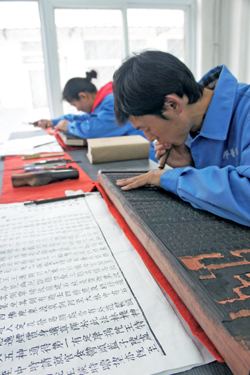
Since late January, hundreds of cultural heritage preservationists have been working in a tightly guarded compound in Yufa, Daxing district, southern Beijing, on a batch of vintage woodblocks inscribed with the Qianlong Great Buddhist Canon.
Also known as Tripitaka or Dragon Tripitaka, it is the last official edition of the Buddhist Tripitaka and the only one existing in China.
It was carved on 79,036 pear-wood blocks during the reign of Emperor Yongzheng in 1733 and completed during the reign of Emperor Qianlong in the Qing Dynasty (1644-1911) in 1738.
The carved woodblocks of 724 cases and 7,240 volumes, are a complete collection of 1,669 Buddhist sutras, teachings, treatises, biographies, catalogues and other literary content.
"It is a treasure for China and the world's Buddhist community and is of great significance in history, literature and art," says Guo Xiaoling, director of Capital Museum.
A total of 69,410 carved woodblocks have survived the past two centuries and 9,626 pieces are missing. Of the existing carved woodblocks, more than 20 percent have deteriorated, naturally, and require urgent preservation.
 |
|
These woodblocks printed the last and only official edition of Buddhist Tripitaka existing in China. Photo by Zhu Linyong / China Daily |
Since early 2011, Capital Museum has organized a team of experts, headed by Peking University professor of cultural heritage conservation Hu Dongbo, to formulate a blueprint for the protection and conservation of the Buddhist canon woodblocks.
On Feb 28, the museum and Bank of America Merrill Lynch launched a mission to clean a portion of the woodblocks with ink residue. The project will run for about 200 days.
The museum has received funding through the bank's global Art Conservation Project. But the two parties declined to reveal the amount.
Funding from the bank is only enough to support the cleaning of some 5,000 pieces.
"A comprehensive conservation process of the whole set of Buddhist canon woodblocks requires much more funding and is expected to run for eight to 10 years," says He Weiliang, who is in charge of the cleaning task.
After cleaning the ink residue left between the characters on all the damaged woodblocks, preservationists will then repair worn-out characters, restore the missing characters, correct erroneous characters, re-carve 9,626 pear-wood blocks and build a digital database for all carved content, He explains.
For the re-carving and restoring work, master wood carvers, such as Ma Xiqin, have been called in.
Ma has accumulated rich experience carving New Year picture woodblocks and Buddhist scriptures in Wuqiang county, Hebei province.
To gather information about the missing characters and missing blocks, experts will travel to Buddhist temples and libraries, hunting for old editions of the Buddhist canon, printed with the Qianlong Great Buddhist Canon Carved Woodblocks.
After the project wraps up, limited editions of the Buddhist canon will then be reprinted and distributed to major museums worldwide for academic use.
And a museum will be constructed in Beijing to house the restored Buddhist canon woodblocks so the public can learn about the history and cultural messages of the works.
"It is a good and innovative trial to diversify the source of funding to protect national treasures, such as the Qianlong Great Buddhist Canon," Guo Xiaoling says.
"We hope corporate entities play a more active role in grand-scale cultural relic conservation projects in the future."